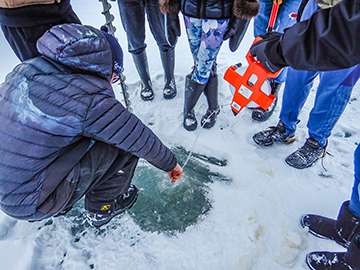Examples of Community Engagement in NSF-funded Research

Image: Measuring ice thickness on Third Lake in Noatak, Alaska,
Brett Pietila, Napaaqtugmiut School
Given the deep knowledge held by local and Indigenous residents in the Arctic, NSF recognizes the importance of collaboration with Arctic residents and welcomes collaborations that improve NSF-funded research. NSF also appreciates that these collaborations can take a variety of forms based on the nature of the scientific projects, needs and unique strengths of community members and organizations, and the scope of planned collaboration. The following exemplify possible forms of engagement but do not comprise an exhaustive list.
Research Sites Near Local and Indigenous Communities or Their Lands. Proposers preparing projects working near, with, or impacting, local and Indigenous communities are strongly recommended to engage communities early in the proposal development stages, not once the proposal is developed. In accordance with the Interagency Arctic Research Policy Committee (IARPC) Principles for Conducting Research in the Arctic, researchers should coordinate their field activities with nearby communities and are expected to share results with the community following each field season and/or at the end of the project. Investigators should include travel funds for this in their proposal budgets. Some projects may require discussion with tribal or subsistence co-management organizations at the proposal stage and prior to fieldwork. Time for these discussions and planning should be included in the project schedule, and travel and salary funds for the discussion participants should be included in the proposal budget. Investigators interested in utilizing the Arctic Research Support and Logistics (RSL) program's prime logistics support contract (currently Battelle ARO) can also contact ARO science project planners (arctic.planning@battelle.org) in the pre-proposal stage for information about additional support for engagement.
Community engagement and outreach are important components of both integrative research and research capacity-building, which includes developing the next generation of researchers and Indigenous scholars. Here, community engagement refers to substantive interaction with community partner individuals, communities, organizations, and anchor institutions such as governments, federal, state and local agencies, schools, libraries, health and social service providers, tribal and Indigenous-serving organizations, non-profits, cultural organizations, and businesses. In accordance with the IARPC Principles for Conducting Research in the Arctic, investigators and community partners are recommended to work closely to develop and evaluate creative approaches to achieving meaningful engagement for mutual benefit and scientific vitality.
Co-production of Knowledge. NSF identifies co-production of knowledge as the integration of different knowledge systems and methodologies to systematically understand the phenomena, systems, and processes being studied in a research project. In the Arctic, this often takes the form of Indigenous knowledge holders and scientists working closely together to address shared research questions, pursue shared methodologies, and agree upon appropriate outreach and data sharing activities. A co-produced approach includes research in which local and Indigenous peoples and organizations fully engage in the complete research process cycle from the development of research questions, to the collection, use and stewardship of data, and interpretation and application of results. Given the diversity of peoples, worldviews, ideas, approaches, and methodologies in the Arctic, the co-production of knowledge can take various forms. If intending to pursue knowledge co-production, collaboration must begin during the development of the research questions, and PIs are recommended to put into practice the IARPC Principles for Conducting Research in the Arctic.
